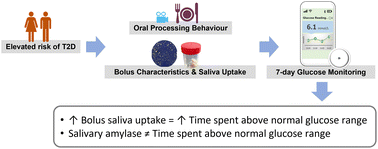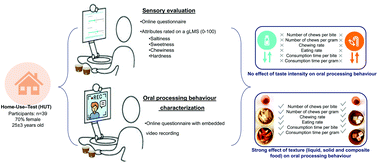Themed collection Food structure, sensory perception, and nutrition

Texture properties of foods targeted for individuals with limited oral processing capabilities: the elderly, dysphagia, and head and neck cancer patients
Food texture is important for food enjoyment and modulation of food intake, particularly in individuals with limited oral processing capabilities (OPC), such as the elderly, dysphagia, and head and neck cancer (HNC) patients.

Food Funct., 2023,14, 3949-3965
https://doi.org/10.1039/D3FO00363A
Visualizing morphological structures of rice grains in precooked products using synchrotron radiation X-ray phase-contrast computed tomography
The morphology and internal structure of precooked rice products were successfully visualized without contrast agents by synchrotron radiation X-ray phase-contrast computed tomography (CT).

Food Funct., 2023,14, 87-93
https://doi.org/10.1039/D2FO02714C
Associations between oral processing, saliva, and bolus properties on daily glucose excursions amongst people at risk of type-2 diabetes
Greater bolus saliva uptake was associated with a higher time spent above the normal range for blood glucose. Salivary amylase and saliva flow rate were not significantly associated with the time spent above the normal range.

Food Funct., 2023,14, 2260-2269
https://doi.org/10.1039/D2FO03060H
Independent and combined impact of texture manipulation on oral processing behaviours among faster and slower eaters
Food texture combinations have a stronger impact in moderating oral processing behaviours and eating rate (g min−1), than individual texture changes. This effect was the same for faster and slower eaters.

Food Funct., 2022,13, 9340-9354
https://doi.org/10.1039/D2FO00485B
Chewing differences in consumers affect the digestion and colonic fermentation outcomes: in vitro studies
Differences in chewing behavior results in differences in physical properties of the ready-to-swallow bolus and greatly impacts in vitro starch digestion and colonic fermentation with changes in bacterial composition and microbial acid metabolites.

Food Funct., 2022,13, 9355-9371
https://doi.org/10.1039/D1FO04364A
Oral processing behaviours of liquid, solid and composite foods are primarily driven by texture, mechanical and lubrication properties rather than by taste intensity
The aim of the study was to understand the effect of saltiness and sweetness intensity on oral processing behaviours of liquid, solid and composite foods using a HUT test.

Food Funct., 2022,13, 5011-5022
https://doi.org/10.1039/D2FO00300G
Experimental and numerical evaluation of the effect of micro-aeration on the thermal properties of chocolate
A multiscale Finite Element Model, validated by heat transfer experiments, is proposed to study the effect of micro-aeration on the thermal properties of chocolate. This model links microstructural changes to changes in chocolate's thermal behaviour.

Food Funct., 2022,13, 4993-5010
https://doi.org/10.1039/D1FO04049A
Ethnicity impact on oral processing behaviour and glycemic response to noodles: Chinese (Asian) vs. New Zealander (Caucasian)
Results of this study confirmed the significance of oral processing in determining food digestion, and provide new insights on the role of ethnicity in influencing people's physiological response to food.

Food Funct., 2022,13, 3840-3852
https://doi.org/10.1039/D1FO04078B
Variations of the viscous properties of a sponge cake artificial bolus with some physiological parameters
Flow curves of cake bolus at two levels of artificial saliva follow the Herschel–Bulkley model, allowing for the derivation of the food/saliva interaction coefficient.

Food Funct., 2022,13, 3198-3205
https://doi.org/10.1039/D1FO04213K
Elucidation of a lingual detection mechanism for high-viscosity solutions in humans
Longer filiform papillae and a higher density on the tongue are associated with sensitivity to viscous solutions corroborating prior theoretical models. From these perceptual and anatomical data, a new model of filiform-based perception is proposed.

Food Funct., 2022,13, 64-75
https://doi.org/10.1039/D1FO02460D
About this collection
This is a collection of papers consisting of invited contributions from the 6th International Conference on Food Oral Processing, July 12-14, 2021. This includes the following topics;
- Effect of oral processing on biochemical and physiological actions of food components and bioactives in the body
- Influence of oral processing on release, bioaccessibility and bioavailability of nutrients and bioactive food components
- Impact of oral processing on food digestion and metabolism
- Physics of food oral processing
- Influence of oral processing on food and energy intake
Guest Edited by Anwesha Sarkar, Markus Stieger and Susana Fiszman. New articles will be added to this collection as they are published.